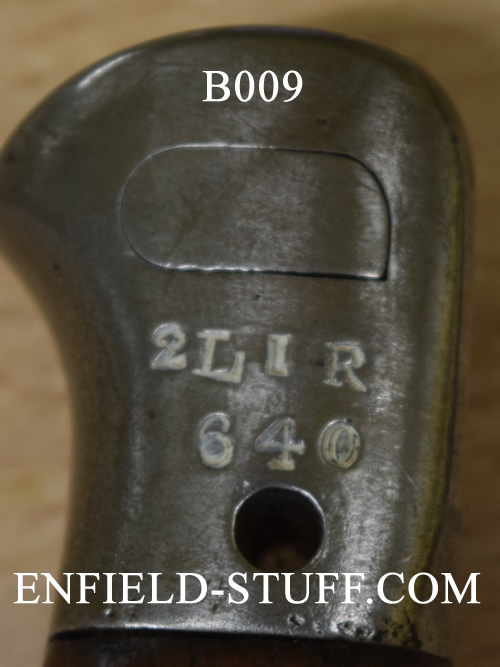 |
Bayonet 009
Pattern of 1907 bayonet; Wilkinson 11-1917. Marked 2 LIR over 640. 2ND KING’S LIVERPOOL REGIMENT. Round button scabbard: WJH/B stamps on locket and chape; leather faint and hard to read. With cap badge.
|
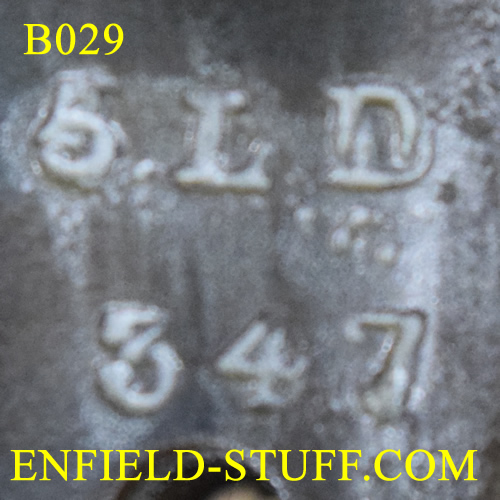 |
Bayonet 029
Pattern of 1907 bayonet; Sanderson 06-1917. Marked 5 LD over 347. 5TH CITY of LONDON. Multiple arsenal rework dates.
|
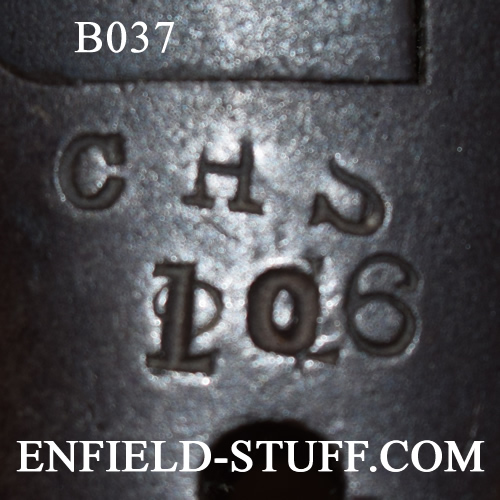 |
Bayonet 037
Pattern of 1907 bayonet; RSAF ENFIELD 10-1910. Marked 3 SG (overstruck). Marked OTC WIL over 56 on reverse. 3RD SCOTS GUARD REGIMENT / WILSON SCHOOL / OFFICER TRAINING CORPS. Worn marks, multiple arsenal rework dates. (’09; ’14; ’38) Round button scabbard: Faint stamps on locket and flat-end chape; No visible stamps on leather. With cap badge.
|
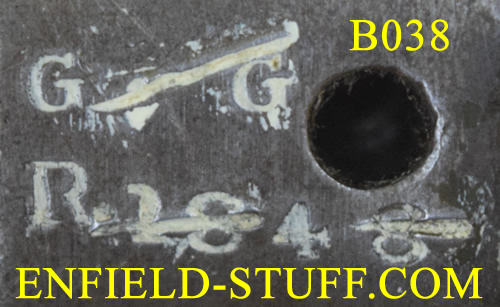 |
Bayonet 038
Pattern of 1907 bayonet; Wilkinson 10-1917. Marked GG over R 1848. Overstruck. GRENADIER GUARDS REGIMENT.
|
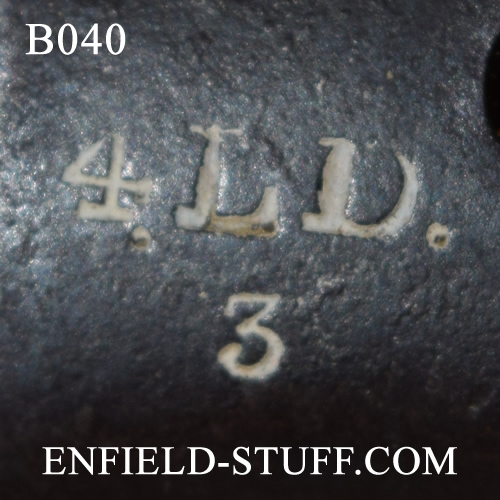 |
Bayonet 040
Pattern of 1907 bayonet; Sanderson 04-1918. Marked 4 LD over 3. 4TH CITY OF LONDON. Teardrop button Remington scabbard: Faint stamps on locket and flat-end chape; marking’17 visible on leather.
|
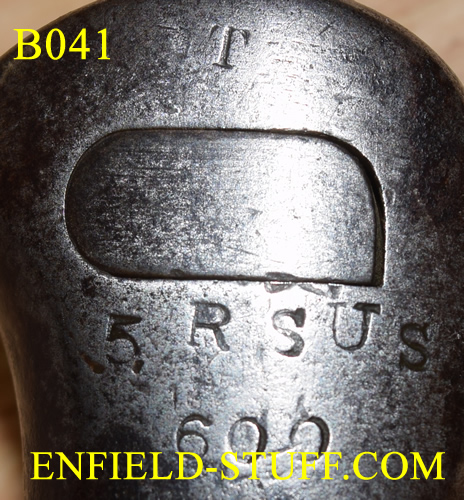 |
Bayonet 041
Pattern of 1907 bayonet; Chapman 04-1909. Marked T over 5 R SUS over 600. (TERRITORIAL) 5TH ROYAL SCOTS + ?. Quillion removed; drilled clearance hole. Arsenal rework dates ’10, ’11, ’13, and ’23. Round button Orange Arsenal scabbard: Faint stamps on locket and flat-end chape; marking MANGROVITE 42 visible on leather.
|
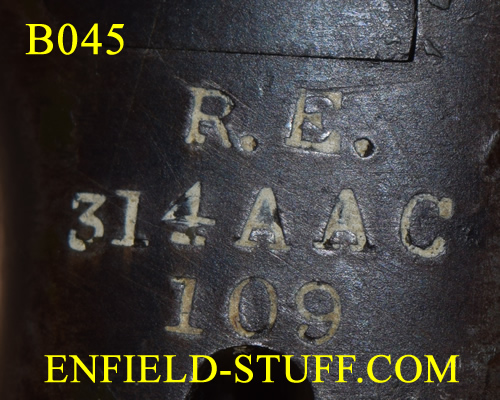 |
Bayonet 045
Pattern of 1907 bayonet; Wilkinson PALL MALL xx-1918. Marked T over RE over 314 ACC over 109. (TERRITORIAL) ROYAL ENGINEERS ANTI-AIRCRAFT COMPANY.
|
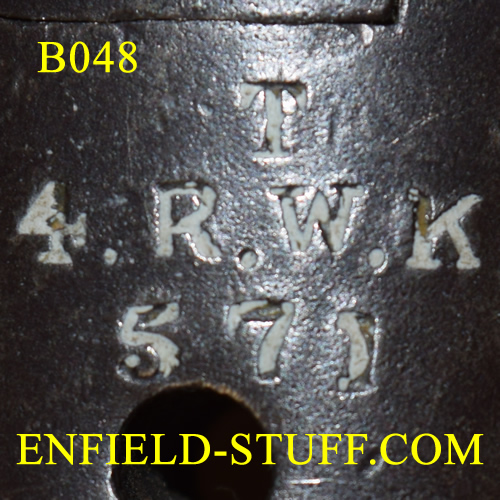 |
Bayonet 048
Pattern of 1907 bayonet; Wilkinson 10-1918. Marked T over 4 RWK over 571. (TERRITORIAL) 4TH QUEENS OWN ROYAL WEST KENT REGIMENT. Lithgow scabbard.
|
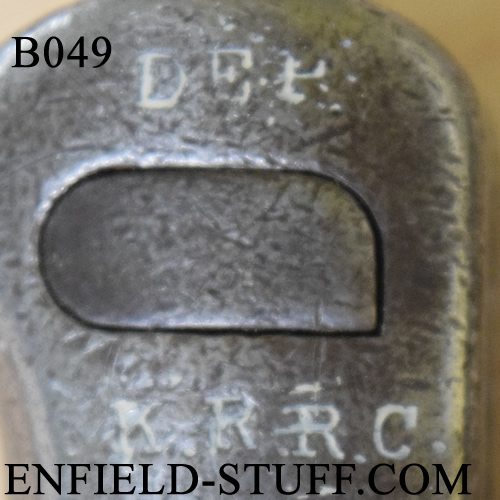 |
Bayonet 049
Pattern of 1907 bayonet; RSAF ENFIELD 03-1915. Marked DEP over KRRC over 12. DEPOT KINGS ROYAL RIFLE CORPS. Multiple arsenal rework dates. Scabbard EFD 1916. With cap badge.
|
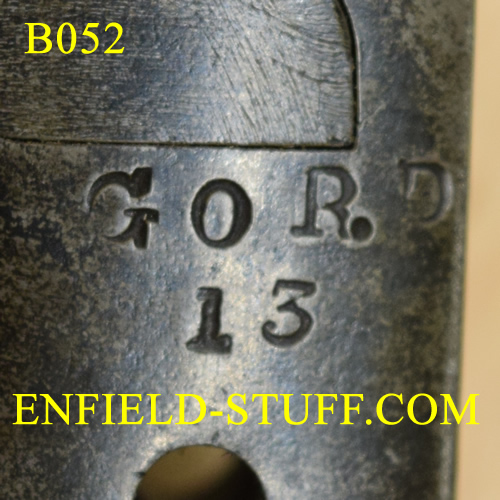 |
Bayonet 052
Pattern of 1907 bayonet; Wilkinson ??-1918. Marked GOR D over 13. GORDON HIGHLANDERS / DEPOT. Maybe.
|
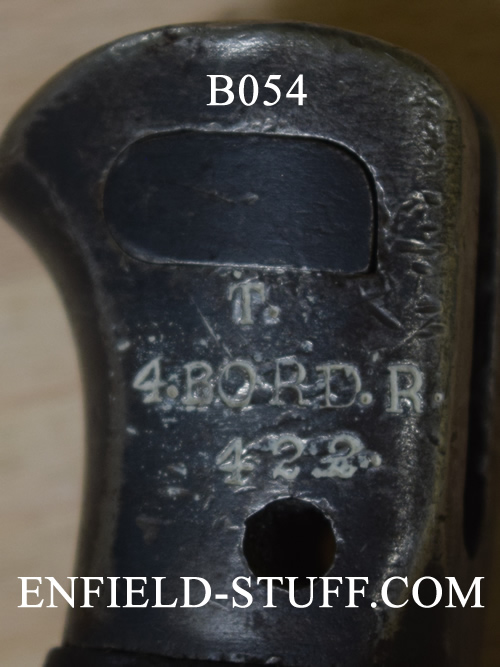 |
Bayonet 054
Pattern of 1907 bayonet; Sanderson 04-1917. Marked T over 4 BORD R over 432. (TERRITORIAL) 4TH BORDER REGIMENT. Round button scabbard: Faint stamps on locket and chape; leather faint and hard to read. With cap badge.
|
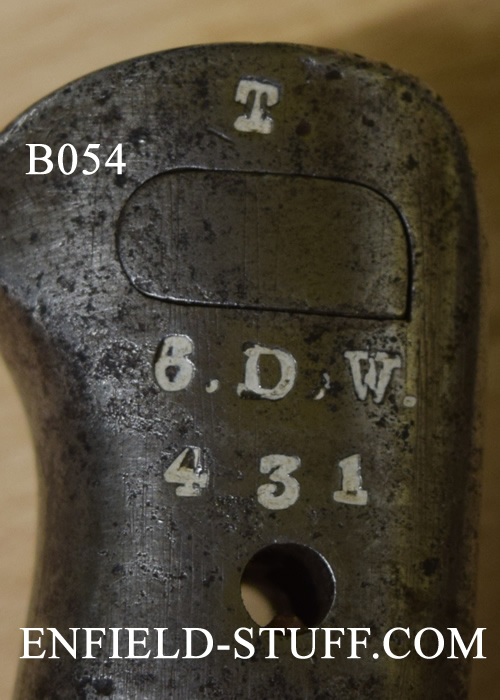 |
Bayonet 055
Pattern of 1907 bayonet; Wilkinson 07-1917, Marked T over 8 DW over 431. (TERRITORIAL) 8TH DUKE OF WELLINGTON’S WEST RIDING REGIMENT. Multiple arsenal rework dates. Round button scabbard: Faint stamps on locket and chape; leather faint (EFD 1918) and hard to read. With cap badge.
|
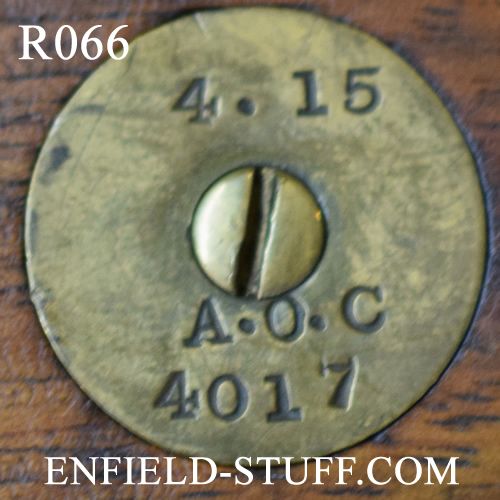 |
Rifle 066
SMLE No. 1 Mk III Enfield 1904. Originally a Mk I with the sliding charger guide, this volley-sighted rifle was upgraded to Mk III configuration to work with the Mk VII HV round. Dated 4-15 (April 1915) and marked AOC (Army Ordnance Corps).
|
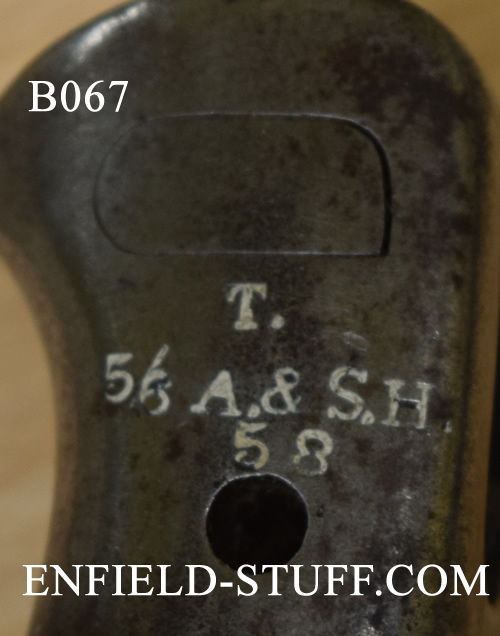 |
Bayonet 067
Pattern of 1907 bayonet; Wilkinson 03-1918. Marked T over 5/6 A&SH over 58. (TERRITORIAL) ARYYLL & SUTHERLAND HIGHLANDERS. Multiple arsenal rework dates. Round button Orange Arsenal scabbard: Clear stamps on locket and flat-end chape; leather MANGROVITE 43. With cap badge.
|
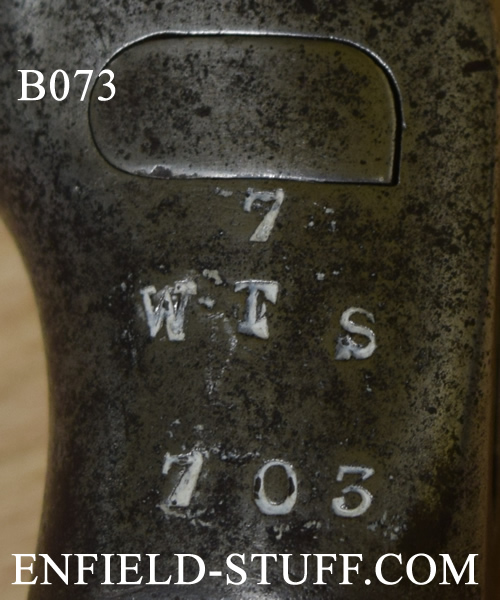 |
Bayonet 073
Pattern of 1907 bayonet; Wilkinson 07-1915. Marked 7 over WTS over 703. 7TH DUKE OF EDINBURGH’S WILTSHIRE REGIMENT. No clearance hole. No, repeat NO, arsenal rework dates. Round button Orange Arsenal scabbard: Clear stamps on locket and flat-end chape; leather MANGROVITE 43. With cap badge
|
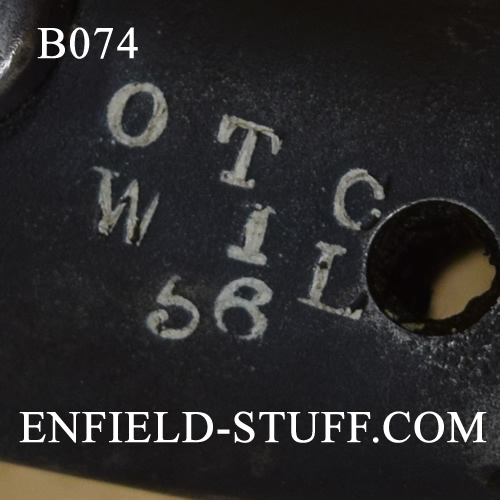 |
Bayonet 074
Pattern of 1907 bayonet; RSAF ENFIELD 10-1910. Marked 3 SG (overstruck). Marked OTC WIL over 56 on reverse. 3RD SCOTS GUARD REGIMENT / WILSON SCHOOL /OFFICER TRAINING CORPS. Worn marks, multiple arsenal rework dates. (’09; ’14; ’38) Round button scabbard: Faint stamps on locket and flat-end chape; No visible stamps on leather. With cap badge.
|
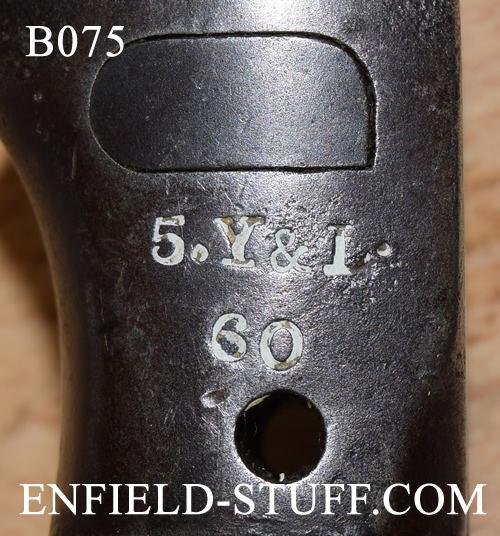 |
Bayonet 075
Pattern of 1907 bayonet; Chapman 11-1917. Marked 5Y&L over 60. 5TH YORK & LANCASTER REGIMENT. Multiple arsenal rework dates. Round button scabbard: Faint stamps on locket and flat-end chape; HGR ’17 visible on leather. With cap badge.
|
 |
Bayonet 082
Pattern of 1907 bayonet; Wilkinson 12-1916. Marked T over 7 WORC over 637. (TERRITORIAL) 7TH WORCESTER REGIMENT. Teardrop button Remington scabbard: Faint stamps on locket and flat-end chape; marking’17 visible on leather. With cap badge.
|
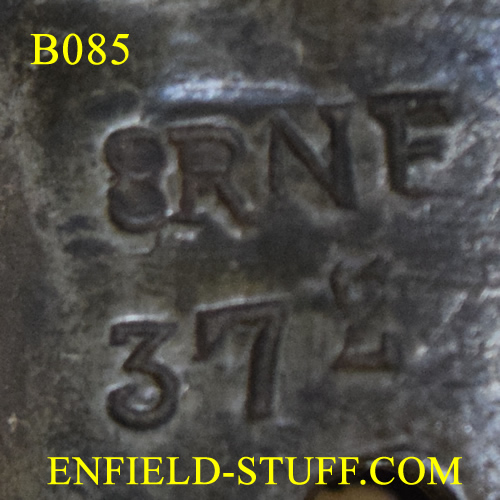 |
Bayonet 085
Pattern of 1907 bayonet; Marked 8 RNF over 372. 8TH ROYAL NORTHUMBERLAND FUSILIERS. Arsenal rework dates ’23 and ’28. BSA scabbard.
|
 |
Rifle 088
SMLE No.1 Mk III* BSA 1918. All matching; marked DEP SHROP on buttstock marking disc. The King's (Shropshire Light Infantry) 13 battalions saw service all over the globe. In 1918 the 1st was in France; the 2nd in Salonika, soon to depart for South Russia; the 3rd and 4th India, Burma, Singapore, Hong Kong and Colombo; 5th, 6th & 7th in France; 8th in Salonika; 10th in Egypt and Palestine.
|
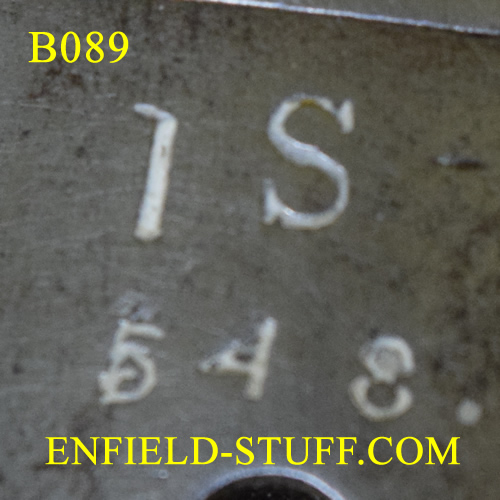 |
Bayonet 089
Pattern of 1907 bayonet; Chapman 07-1917. Marked 1 S over 548. 1ST SUFFEX. Round button Orange Arsenal scabbard.
|
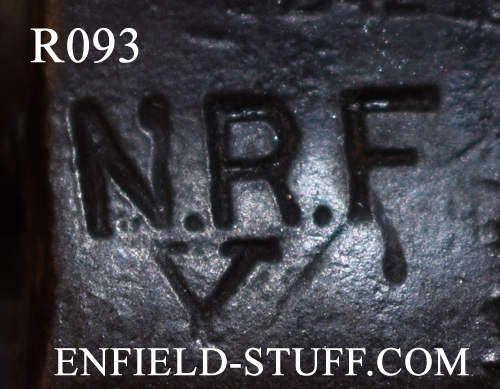 |
Rifle 093
SMLE Rifle No.1 Mk III* NRF 1918. Before the Great War some minor rifle components were produced by non-government factories. This was expanded to a "Peddled Scheme" to increase rifle production. The Standard Small Arms Company (SSA) was set up with a government grant. Under this plan the Standard Small Arms Factory would provide rifles in addition to those produced at RSAF Enfield, BSA, and LSA. SSA was to produce receivers, barrels, and certain other parts and act as an assembly unit for parts produced by other contractors (hence the name "Peddled Scheme" since the parts were "peddled" to outside civilian contractors). The first contract to deliver SMLE rifles was signed in 1915. Due to mismanagement and other factors, SSA did not deliver its first rifle until late 1916. Even then production was slow. By 1918 only about 200,000 rifles had been delivered and SSA went bankrupt. In June 1918 the British Government bought the facility and established the National Rifle Factory No.1 (NRF) which produced about another 50,000 guns. By the end of the war in November 1918, "Peddled Scheme" rifles accounted for only a small fraction of more than 3 Million SMLE rifles produced by BSA, LSA, and Enfield during WWI. The rifles are marked differently than all other SMLE rifles in that they have no manufacturers name on the buttsocket, with the manufacturer - either SSA or NRF - being stamped on the rear of the receiver to the left of the bolt channel. Overall 90% + finish; wood is VG with only the usual nicks and dents. Matched (bolt, receiver, barrel, rear sight leaf, nosecap, forestock). No import marks.
|
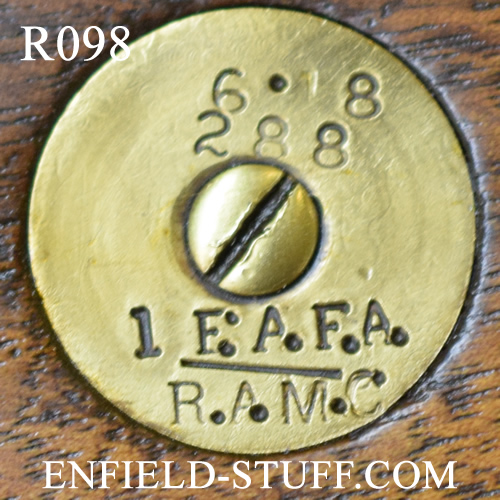 |
Rifle 098
SMLE No. 1 Mk III* BSA 1916. Marked to 1 E.A.F.A./R.A.M.C. (1st East Anglian Field Ambulance/Royal Army Medical Corps 6/18). In June 1918, the E.A.F.A. was attached to the 2nd Division on the Western Front. Overall 90%, Wood VG with typical small dings and dents. Matched (bolt, receiver, barrel, sight, nosecap, and forestock. No import marks. Field Ambulance marked pieces are very rare.
|
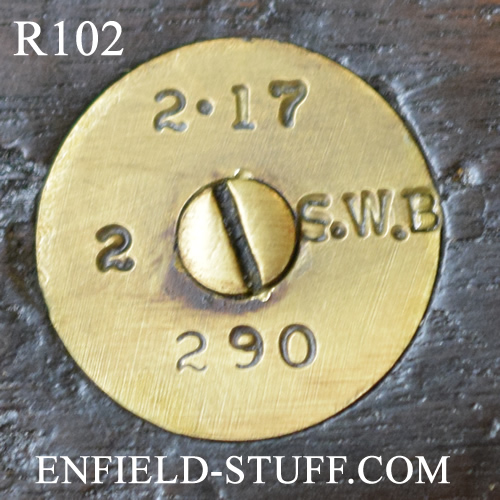 |
Rifle 102
SMLE No. 1 Mk III* BSA 1916. Marked “2 S.W.B.” and dated “2 17” – the 2nd Battalion, South Wales Borderers. Raise as Dering’s Regiment in 1689, the South Wales Borderers (then known as the 24th Regiment of Foot) are probably best known for the defense of Roark's Drift in the Zulu War. In 1914 the 2nd Battalion (along with the Japanese Army) took the German concession of Tsingtao in China. The battalion was then part of the ill-fated Gallipoli Expedition in 1915. In March of 1916 the battalion was sent to France where it remained until 1919 – only to be sent to India to serve in the 3rd Afghan War. By November 1918 the regiment numbered 18 battalions. Overall 90% + finish; wood is VG with only the usual nicks and dents. Matched (bolt, receiver, barrel, rear sight leaf, nosecap, forestock). No import marks.
|
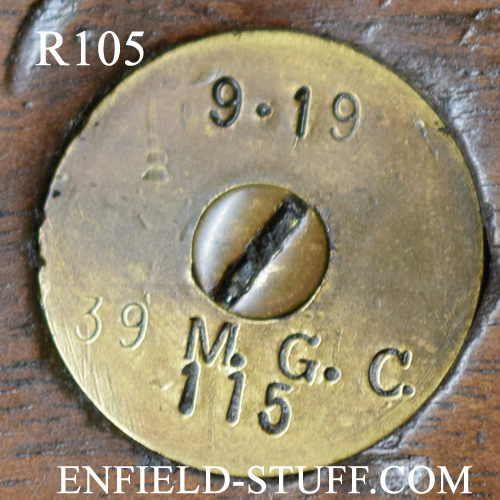 |
Rifle 105
SMLE No. 1 Mk III* EFD 1918. Marking disc is marked “39 M.G.C.” and “9 19” – indicating service with the 39th Machine Gun Company. In 1915 the Army began to form Machine Gun Companies to concentrate the firepower of the newly introduced Vickers MMG. these machine gun units were attached to both infantry and cavalry formations as well as the Motor Machine Gun Sections which were attached to the Royal Tank Corps. Although machine gunners were armed with revolvers, many of these units had to function as infantry and were therefore also equipped with rifles and other infantry kit. The 39th MGC was formed in 1916 and initially served in Mesopotamia. In August 1918 the company was sent to Persia (Iran) and subsequently ordered into Southern Russia under General Dunsterville, where is remained well into 1919 fighting the Bolsheviks on the shores of the Caspian Sea in the area around Baku. Overall 90% finish; wood is VG with only the usual nicks and dents. Matched (bolt, receiver, barrel, rear sight leaf, nosecap, forestock). No import marks.
|
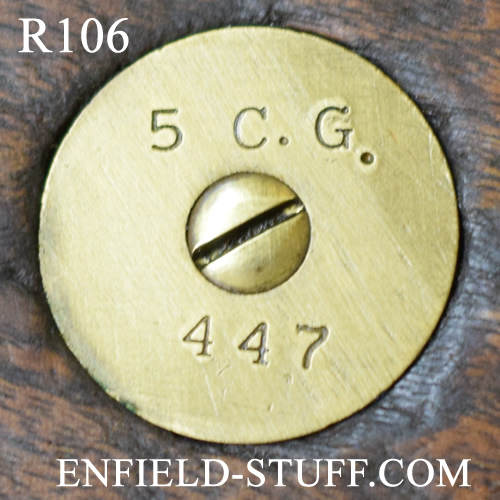 |
Rifle 106
SMLE No. 1 Mk III* (without cut-off) Enfield 1918. Marked "5 C.G.". 5th (Wartime) Battalion Coldstream Guards. The 5 C.G. was part of the 32nd Guards Brigade of the Guards Armoured Division from June 1942 where it served as "lorried infantry" (i.e. mechanized infantry) in support of Guards armoured formations. The Guards Armoured Division was not committed to battle until D-Day, by which time all line formation had been equipped with the Rifle No. 4. Thus, this weapon served in a training status from Dunkirk until just prior to D-Day. Overall 95%. Wood VG with typical small dings and dents. Matched (bolt, receiver, barrel, sight, nosecap, and forestock. No import marks.
|
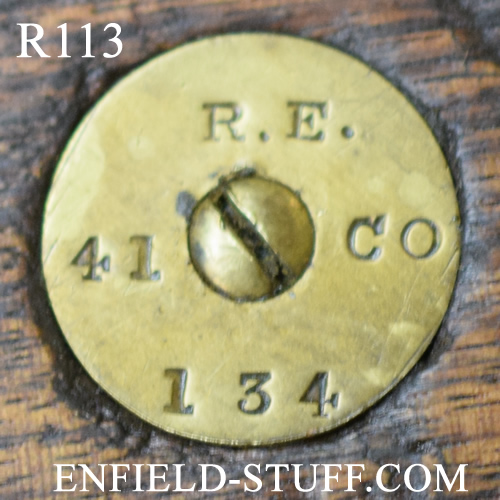 |
Rifle 113
SMLE No. 1 Mk III* Enfield 1918. 41st (Field) Company Royal Engineers. 41 COY was a mine clearance company attached to the British 8th Army during the campaigns in the Western Desert, Tunisia, and Italy. The piece still retains desert camo "sand" colored paint over about 40% of the metal parts. Overall 90%. Wood VG with typical small dings and dents. Matched (bolt, receiver, barrel, sight, nosecap, and forestock. No import marks.
|
 |
Rifle 114
SMLE No. 1 Mk III BSA 1938. Marked " 4 KOYLI". 4th Battalion Kings Own Yorkshire Light Infantry. Finish 95%. Wood VG. Matched. No import marks.
|
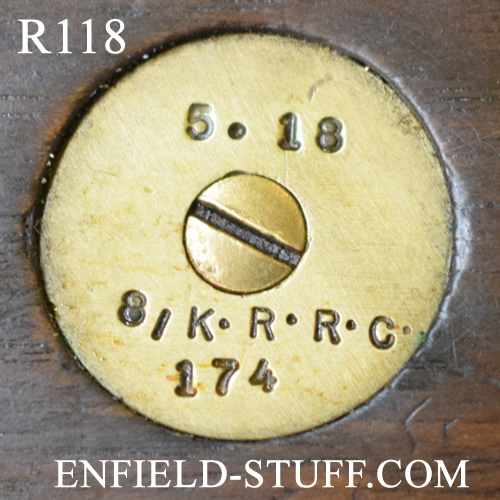 |
Rifle 118
SMLE No. 1 Mk III* Enfield 1918. 8 K.R.R.C. (8th Battalion Kings Royal Rifle Corps – The 60th Rifles, 5/18). In May 1918 the 8 KRRC was serving in France. It was disbanded in France in August 1918. Overall 95%. Wood VG with typical small dings and dents. Matched (bolt, receiver, barrel, sight, nosecap, and forestock. No import marks.
|
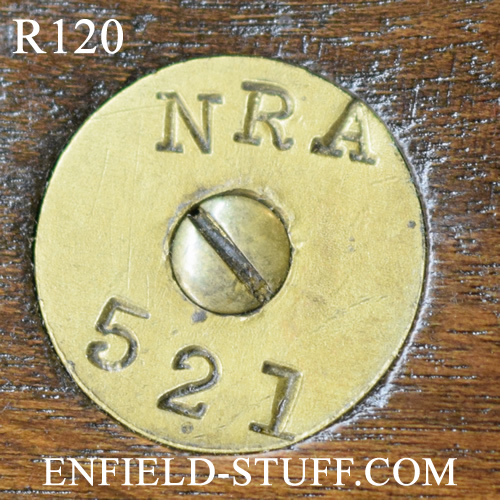 |
Rifle 120
SMLE No. 1 Mk III (with cut-off) BSA 1940. Marked with both military acceptance proofs and the BSA "tepee" logo on the knox form. Marked on the stock disk "NRA" indicating it was part of the British National Rifle Association's service rifle marksmanship program (probably post-WWII). Overall 98%. Wood Excellent - very fine walnut which appears virtually new. Even the buttplate has no scratches or dents. Matched (bolt, receiver, barrel, sight, nosecap, and forestock. No import marks. A beautiful SMLE in just about factory new condition.
|
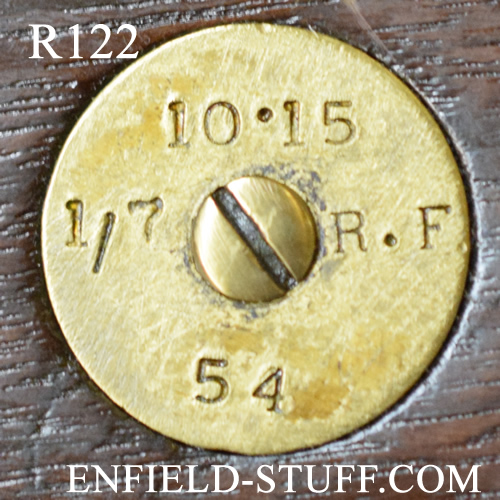 |
Rifle 122
SMLE No. 1 Mk III LSA 1915. With long range auxiliary sights and windage rear sight. Marked on stock disk "10 15" and "17 RF" indicating that it was in use by the 17th (1st Public School) Battalion of the Royal Fusiliers (The City of London Regiment) in October 1915. The 17th Battalion entered the line in France in November 1915 and was disbanded in France on 24th April 1916 at which time the survivors were commissioned as volunteer officers and posted to other regiments. A number of these men ultimately achieved General Officer rank in the regular army. Overall 90%. Wood VG with typical small dings and dents. Matched (bolt, receiver, barrel, sight, nosecap, and forestock. No import marks.
|
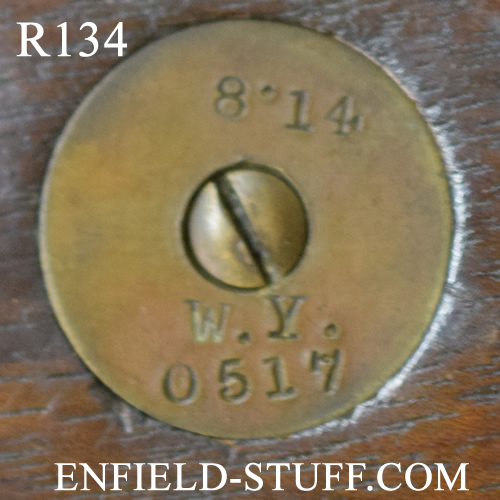 |
Rifle 134
1904 BSA. The rifle is all matching except for the bolt, cartouche is faint but if held right visible. Barrel is undated, replaced during upgrade to Mk I*. "V" notch sight with barley corn front sight, rear sight ramp still "high", thus still set up for Mk VI ammo. Type 4 mag , no import marks. Marked W.Y. - (The Prince of Wales' Own) West Yorkshire Regiment August 1914. Overall very good wood (usual dings and bruises), very good plus metal. Complete with cut-off and volley sights. The very first day of the Battle of the Somme the 10th Battalion sustained 710 casualties. A handful of men were brought out by their only surviving officer, a wounded 2nd Lieutenant.
|
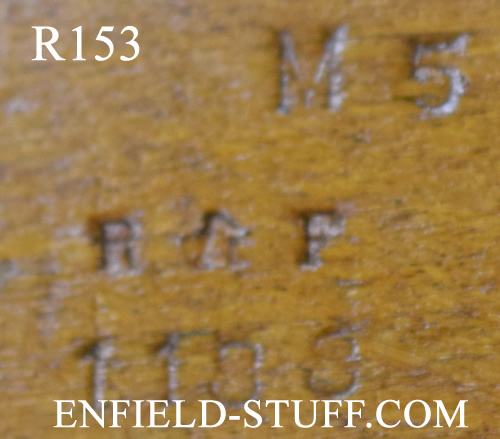 |
Rifle 153
SMLE No. 1 Mk III* BSA 1941. A typical "Dispersal Rifle" without the BSA cartouche on the buttsocket. Barrel is dated '41 and is marked with a combination of BSA commercial "BM" proofs and military broad arrow. Buttstock is marked "R.A.F. over 1122". Royal Air Force. All furniture is birch and is in VG+ condition. Finish is 95%+. Except for a couple of storage dings, the weapon appears unissued. All matching (receiver, barrel, bolt, sight, nosecap, and forestock). No import marks. An unusually nice specimen with rather uncommon RAF markings.
|
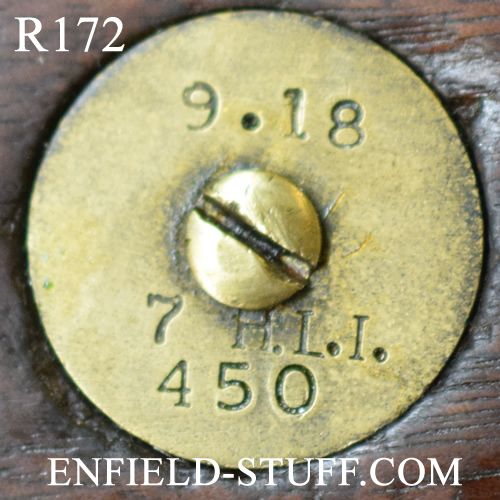 |
Rifle 172
SMLE No. 1 Mk III* Enfield 1916. Marked to the 7th Battalion Highland Light Infantry ( 7 H.L.I.) and dated September 1918 (9 18) on the marking disk. The 7th Battalion was a wartime battalion, which saw initial service at Gallipoli (along with the 5th and 6th Battalions of the H.L.I.) in 1915. In 1917 the battalion was sent to Palestine where it served with General Allenby until being sent to France in April of 1918. In September 1918, the battalion was in service on the Western Front. Overall 90%. Wood VG with typical small dings and dents. Matched (bolt, receiver, barrel, sight, nosecap and forestock. No import marks. Exotic and rare.
|
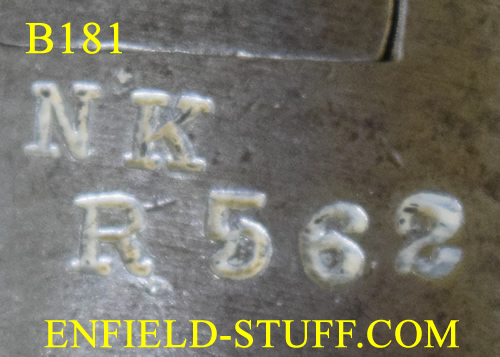 |
Bayonet 181
Pattern of 1907 bayonet; Wilkinson 01-??, Marked NK over R 562. NORFOLK REGIMENT.
|
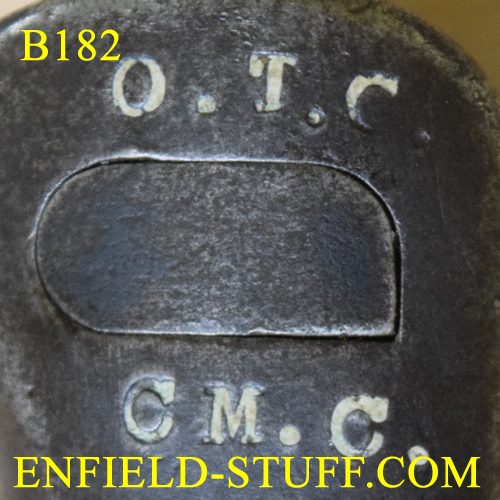 |
Bayonet 182
Pattern of 1907 bayonet; VICKERS 05-1918. Marked OTC over CMC over 165. OFFICER TRAINING CORPS / CHELTHAM COLLEGE. Multiple arsenal rework dates (’30, ’34, ’38). Those college kids must have been pretty hard on the equipment. Round button Lithgow MA scabbard.
|
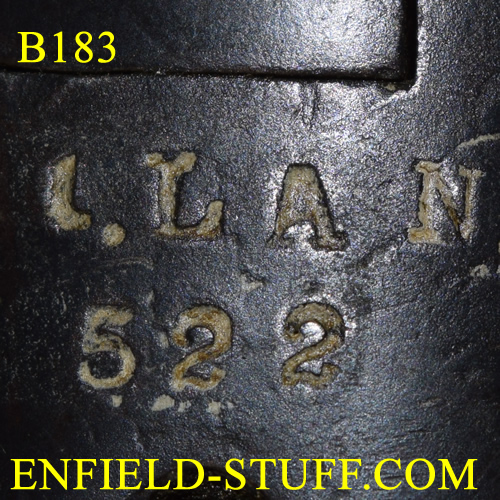 |
Bayonet 183
Pattern of 1907 bayonet; Wilkinson 09-1918. Marked 1 LAN over 522. 1ST KING’S OWN ROYAL LANCASTER. EFD scabbard with very clear and pretty ’14 date stamps.
|
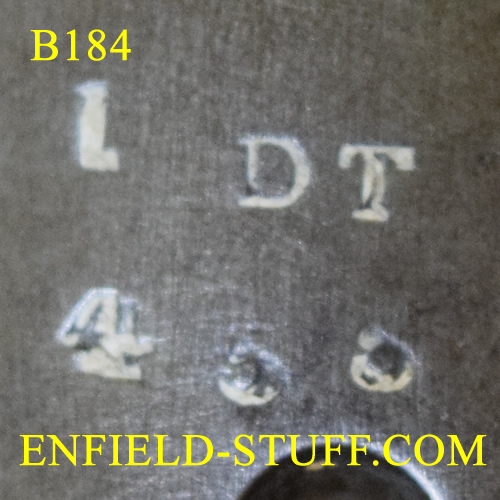 |
Bayonet 184
Pattern of 1907 bayonet; VICKERS 05-1918. With large Vickers-type clearance hole on pommel. Marked 1 DT over 455. 1ST DORSETSHIRE REGIMENT. No arsenal markings. Remington scabbard.
|
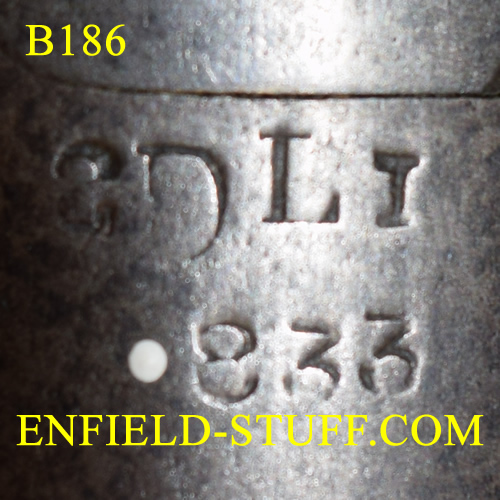 |
Bayonet 186
Pattern of 1907 bayonet; RSAF Enfield 05-1920, Marked *DLI over 833. (*=undecipherable at the moment) DURHAM LIGHT INFANTRY. With DLI cap badge.
|
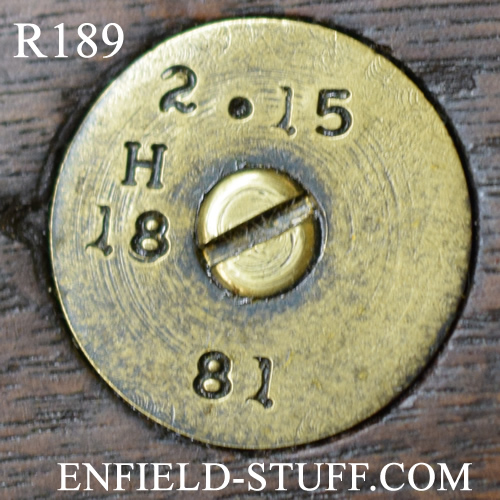 |
Rifle 189
SMLE Rifle No. 1 Mk III London Small Arms 1915. Marking disk is marked to the 18th (Queen Mary's Own) Hussars and dated February 1915. The 18th Hussars arrived in France on 7th August 1914 and fought in virtually every engagement of the war in France until its departure for India in December 1919. The regiment was combined with the 22nd Hussars in 1922. The weapon itself is overall 90% finish. Wood is VG with the usual nicks and dings from service. Matching - bolt, receiver, barrel, rear sight, nosecap, and forestock. With windage adjustable rear sight, front dial pointer and plate, and rear aperture. No import marks. A fine a specimen of a Mk III Type 1 with excellent WWI bona fides.
|
 |
Rifle 215
SMLE Rifle No. 1 Mk III* BSA 1918. Matched serial numbers except for bolt. Buttstock marking disc dated 10-19 and marked 1 NN (1st Battalion Northamptonshire Regiment). Founded in 1741 as James Cholmondeley's Regiment of Foot; renamed the 1st Battalion, Northamptonshire Regiment in 1881. Nicknamed 'The Steelbacks.' The Northampts arrived in France/Flanders on 13th August 1914. The only officer left to lead the battalion out of the trenches after the First Battle of Ypres was a Special Reserve subaltern. In August 1919 the 1st Battalion was sent to Ireland where they remained until December 1922.
|
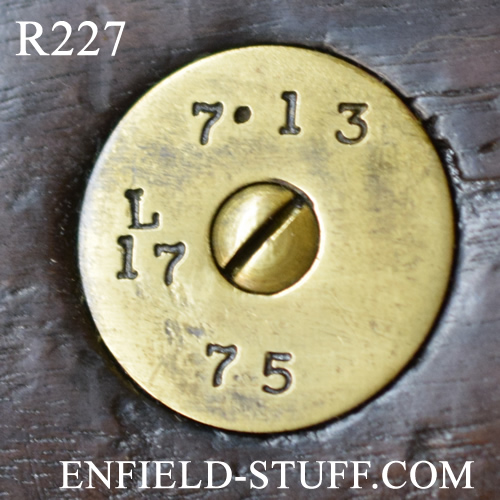 |
Rifle 227
SMLE Rifle No. 1 Mk III LSA 1913. Stock marking disk is dated "7 13" and is marked "L" over "17" indicating the 17th (Duke of Cambridge's Own) Lancers. The 17th Lancers were formed in 1759 as the 18th Light Dragoons. They are most famous for their service in the Crimean War where they were part of the "Light Brigade" whose fatal charge "into the valley of death" has been immortalized in both poetry and film (with Erol Flynn no less!). There motto was "Death or Glory" and their insignia a skull and crossed bones. They served in the Zulu War of 1879 and in 1899 they were sent to South Africa and served there throughout the Boer War, returning to England in 1902. In 1913 they were in barracks at Sialkot, India on the Northwest Frontier. The piece itself is correct in all respects as it came from the factory in 1913 - i.e., long range sights, windage adjustable rear sight, and lightened rear sight protector. In addition, the piece was never modified for small cone ammunition in the 1920's and does not bear the "SC" stamp behind the rear sight base. Both receiver and knox form are stamped "EY" indicating that this piece was downgraded to second line status and placed in war reserve storage. Since "EY" guns did not undergo the periodic "upgrades" of first line weapons, it remained in original unaltered status. Overall 90%+ finish. Wood is VG with the usual scuffs and scratches of long service. Matching - barrel, receiver, bolt, rear sight, nosecap, and forestock. No import marks. A very fine early Mk III with impeccable regimental credentials.
|
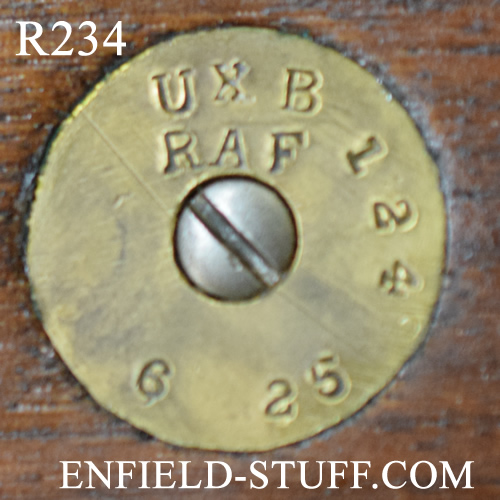 |
Rifle 234
SMLE Rifle No. 1 Mk III Enfield 1915. Stock disk is marked "RAF", "UXB (RAF Uxbridge)" and "6 25". Forestock is a post-1916 replacement without long range sights, although the gun does retain its original windage rear sight. If memory serves, this is the RAF station and about the time frame when T.E Lawrence took is last and still mysterious motorcycle ride. 90% finish. Wood is VG with usual dings. Matched. No import. New category here: "haunted militaria". Wingman to Rifle 156 (above).
|
 |
Rifle 237
SMLE Rifle No. 1 Mk III SSA 1918. An SSA Mk III* upgraded to Mk III at the Royal Naval Ordnance Depot Portsmouth in July 1937. Receiver has been cut for cutoff. New forestock. Barrel is marked "P/N/1", " '29", and "7 37" on the left side of the chamber. Left buttsocket marked "N" as is the tang of the buttplate. Stock marking disk is steel and is marked "N". Overall about 90% finish. . Wood is VG, with rather fewer dings than the average bear. Nice looking gun. Matched. No import marks. All we need is some fish and chips wrapped in newspaper and this sailor is as authentic as it gets.
|
 |
Rifle 229-22
Rifle No.9 Mk I Enfield 1959. Last of the Enfield .22 caliber training rifles, Parker-Hale converted about 3,000 No.4 rifles as a special contract for the Royal Navy between 1956 and 1960. This specimen was converted in 1959 and is number 2100. This model uses the same system developed before WWI that was used in the .22 RF Patt '14 Short Rifles where the barrel was bored out and a .22 liner sleeved onto the barrel and trimmed to length. The muzzle crown is stamped PARKERIFLED A.G.P. The original No.4 Mk I sight leaf graduated to 1,300 yards was retained, but a 25-yd mark was inscribed on the left side. Overall VGC. A very scarce rifle.
|